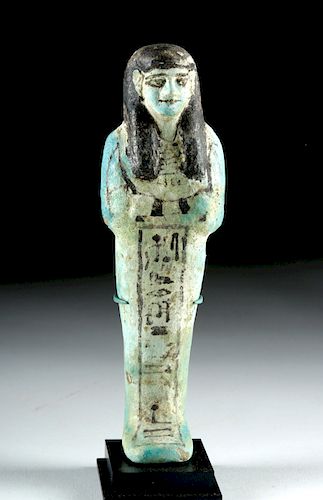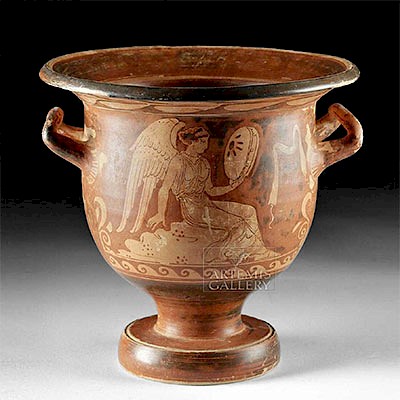Egyptian Third Intermediate Glazed Faience Ushabti
Lot 9
About Seller
Artemis Fine Arts
686 S Taylor Ave, Ste 106
Louisville, CO 80027
United States
Selling antiquities, ancient and ethnographic art online since 1993, Artemis Gallery specializes in Classical Antiquities (Egyptian, Greek, Roman, Near Eastern), Asian, Pre-Columbian, African / Tribal / Oceanographic art. Our extensive inventory includes pottery, stone, metal, wood, glass and textil...Read more
Estimate:
$1,500 - $2,000
Absentee vs Live bid
Two ways to bid:
- Leave a max absentee bid and the platform will bid on your behalf up to your maximum bid during the live auction.
- Bid live during the auction and your bids will be submitted real-time to the auctioneer.
Bid Increments
| Price | Bid Increment |
|---|---|
| $0 | $25 |
| $300 | $50 |
| $1,000 | $100 |
| $2,000 | $250 |
| $5,000 | $500 |
| $10,000 | $1,000 |
| $20,000 | $2,500 |
| $50,000 | $5,000 |
| $100,000 | $10,000 |
| $200,000 | $20,000 |
About Auction
By Artemis Fine Arts
Mar 7, 2019
Set Reminder
2019-03-07 10:00:00
2019-03-07 10:00:00
America/New_York
Bidsquare
Bidsquare : VARIETY SALE | Antiquities & Ethnographic Art
https://www.bidsquare.com/auctions/artemis-gallery/variety-sale-antiquities-ethnographic-art-3928
Around the world & back in time - be amazed at the treasures you will find. Antiquities from Egypt, Greece, Italy and the Near East, Asian, Pre-Columbian, African / Tribal / Oceanic, Native American, Spanish Colonial, Russian Icons, Fine Art, much more! Artemis Fine Arts info@artemisgallery.com
Around the world & back in time - be amazed at the treasures you will find. Antiquities from Egypt, Greece, Italy and the Near East, Asian, Pre-Columbian, African / Tribal / Oceanic, Native American, Spanish Colonial, Russian Icons, Fine Art, much more! Artemis Fine Arts info@artemisgallery.com
- Lot Description
Ancient Egypt, Third Intermediate Period, 21st to 25th Dynasty, ca. 1069 to 664 BCE. A nicely-preserved, mold-formed faience ushabti standing in mummiform atop fused legs and feet. The columnar body traces upwards to rounded shoulders, with crossed arms holding the symbolic pick and hoe, and a broad collar draped across the chest. The stoic visage is comprised of raised almond-shaped eyes, a broad nose, thin lips, and cupped ears, with applied black pigment accentuating each of these areas. The head is capped with a black tripartite wig and lengthy front folds, and a rectangular seed bag is painted along the upper back. A column of black-painted hieroglyphic inscription is displayed along the front of the legs, though many of the symbols are faded and rendered illegible. A nice figural example covered in a vibrant turquoise-hued glaze. Size: 1.8" W x 6.125" H (4.6 cm x 15.6 cm); 6.7" H (17 cm) on included custom stand.
Ushabti were placed in tombs as grave goods, created to do manual labor for the deceased in the afterlife. As a result, they are frequently depicted with arms crossed, holding hoes and baskets. By the Third Intermediate period and on into the Late Dynastic period, this practice had become so necessary and elaborate that some tombs contained one worker for every day of the year and thirty-six overseers, each responsible for ten laborers. Workers like this one are from that period of enormous proliferation, and are some of our best surviving insights into ancient Egyptian funerary practices.
Provenance: private East Coast, USA collection; ex-Richard Wagner collection, Cape Cod, Massachusetts, USA, acquired in the 1960s
All items legal to buy/sell under U.S. Statute covering cultural patrimony Code 2600, CHAPTER 14, and are guaranteed to be as described or your money back.
A Certificate of Authenticity will accompany all winning bids.
We ship worldwide and handle all shipping in-house for your convenience.
#143444Minor chips to glaze on feet, body, and head, fading and yellowing to original pigmentation commensurate with age, with light encrustations, otherwise intact and very good. Light earthen deposits throughout. Nice craquelure to glaze in some areas.Condition
- Shipping Info
-
All shipping is handled in-house for your convenience. Your invoice from Artemis Gallery will include shipping calculation instructions. If in doubt, please inquire BEFORE bidding for estimated shipping costs for individual items.
-
- Buyer's Premium



 EUR
EUR CAD
CAD AUD
AUD GBP
GBP MXN
MXN HKD
HKD CNY
CNY MYR
MYR SEK
SEK SGD
SGD CHF
CHF THB
THB














